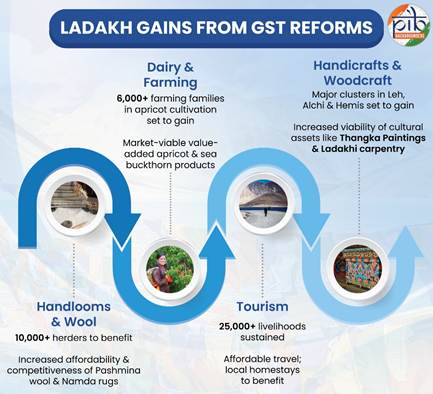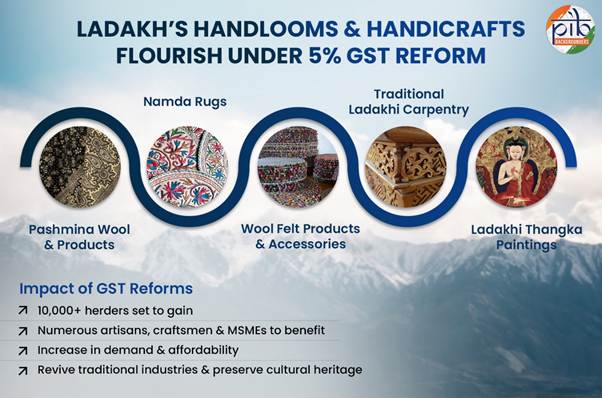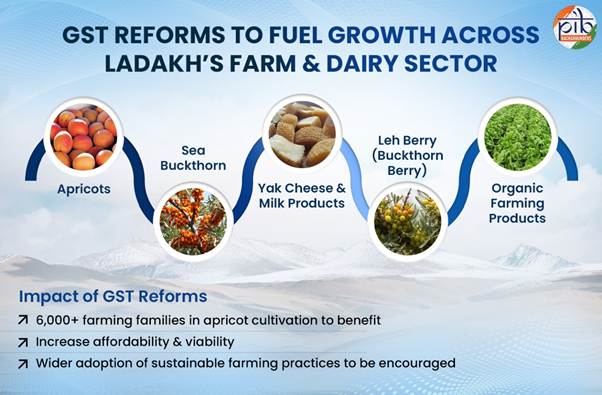Economy
From Pashmina to Apricots: GST Reforms to Boost Ladakh’s Economy
Posted On:
22 OCT 2025 10:02 AM
Key Takeaways
- 5% GST on Pashmina, Namda rugs, and woodcrafts to help 10,000+ artisans
- Dairy and organic farming see better earnings and competitiveness through reduced GST; 6,000+ farming families engaged in apricot cultivation to benefit
- 5% GST on hotel tariffs ≤₹7,500 set to make travel more affordable and sustain livelihood of 25,000+ people
- GST cuts to support yak dairy, wool producers and organic farming, promoting self-sustainability in Ladakh
|
Introduction

Ladakh’s economy is deeply rooted in its unique geography, culture, and craftsmanship, where traditional livelihoods blend with emerging eco-friendly industries. From high-quality Pashmina wool and apricot orchards to intricate Thangka paintings and sustainable tourism, each sector reflects the region’s skill and heritage.
The recent GST reduction across wide variety of products and services will also impact Ladakh’s rich economy, bringing relief to artisans, farmers, and small enterprises. Together, these reforms will support livelihood generation, cultural preservation, and the sustainable growth of Ladakh’s economy.
Handlooms
Pashmina Wool & Products
One of Ladakh’s most valuable traditional crafts, Pashmina wool is produced in the Changthang region in Leh, sustaining over 10,000 nomadic herders. Pashmina is known for its warmth, softness, and fineness, and is used to make premium shawls, stoles, and garments.
The GST reduction from 12% to 5% is expected to boost competitiveness of authentic Ladakhi pashmina against imported or machine-made alternatives. This will also help improve income stability for local herders and artisans and increase the potential for export growth.
Handwoven Woolens & Namda Rugs
Handwoven woollens and Namda rugs from Leh and Kargil represent Ladakh’s rich tradition of wool craftsmanship, using yak and sheep wool to create dyed and distinctive textiles. The GST reduction from 12% to 5% helps lower production costs and encourages the revival of traditional handicraft practices. This is expected to provide significant benefits to local artisans and cooperatives engaged in wool processing and rug making.
Wool Felt Products & Woollen Accessories
Wool felt products and woollen accessories from Leh and Changthang, such as felt boots, hats, and gloves, add to Ladakh’s traditional craft culture. These items are used locally and are also popular purchases amongst tourists. The GST reduction from 12% to 5% provides support to small-scale, seasonal cottage industries engaged in wool processing and product making. It is also expected to strengthen Ladakh’s economy with increased income for artisans.
Handicrafts
Traditional Ladakhi Carpentry
Traditional Ladakhi carpentry from Leh and Kargil features intricately carved wooden altars, window frames, and furniture. The GST reduction from 12% to 5% is expected to make these handcrafted items more affordable and market-competitive. This will support traditional craftsmen, many from marginalized communities, encouraging the preservation of Ladakh’s cultural and artistic heritage.
Ladakhi Thangka Paintings
Ladakhi Thangka paintings, often crafted in the monasteries in Leh, Alchi, and Hemis, are traditional Buddhist scroll artworks used for meditation and decoration. The GST reduction from 12% to 5% makes these intricate paintings more accessible and economically viable, helping preserve a vital part of Ladakh’s cultural heritage.

Local Tourism & Homestays
Local tourism and homestays across Leh, Nubra, Pangong, and Kargil support Ladakh’s service economy, directly employing over 25,000 people. The GST reduction from 12% to 5% on hotel tariffs up to ₹7,500 per night makes travel and accommodation more affordable, particularly during the busy tourist season. This will support the growth of eco-tourism and local homestay economy.
Dairy & Farming Products
Apricots & Apricot Products
Ladakh is India’s largest apricot-producer, with Kargil, Leh, and the Nubra Valley serving as its main production hubs. The GST reduction from 12% to 5% benefits over 6,000 farming families engaged in apricot cultivation and processing. This is expected to improve the competitiveness of locally produced apricots and their value-added products such as dried apricots, jams, and oils, making them more market-viable. It will enable better income opportunities and encourage growth in enterprises engaged in apricot production.
Sea Buckthorn Products
Sea buckthorn, cultivated across the Nubra Valley, Leh, and Changthang regions of Ladakh, is renowned for its medicinal and nutritional properties. Women-led Self-Help Groups (SHGs) play a crucial role in harvesting and processing these berries. The GST reduction from 12% to 5% is expected to enhance the competitiveness of locally made sea buckthorn products, making them more affordable and market-viable.
Yak Cheese & Milk Products
Yak cheese and milk products from Changthang and Nubra are traditional dairy items produced by Ladakh’s nomadic communities. The GST reduction from 12% to 5% will support self-sustainability in remote, high-altitude areas, strengthening local economy.
Leh Berry (Buckthorn Berry)
Leh berry, or buckthorn berry, from Leh and Nubra is used in producing a range of health drinks and supplements. The GST cut from 12% to 5% will encourage investment in local agro-processing, uplifting small producers, and increasing competitiveness.
Organic Farming Products
In Sham Valley and Kargil, organic farming is gaining momentum, with farmers producing herbal teas, dried vegetables, etc. The GST reduction from 12% to 5% supports small-scale eco-farmers by lowering costs and improving profitability. This is expected to encourage wider adoption of sustainable farming practices while strengthening Ladakh’s organic farming economy.

Conclusion
The recent GST reforms mark a transformative step for Ladakh’s economy by empowering its traditional artisans and farmers. From Pashmina weavers and apricot growers to sea buckthorn processors and homestay owners, each sector stands to gain through reduced costs, improved competitiveness, and higher incomes.
Together, these reforms will preserve Ladakh’s rich cultural heritage, strengthening its eco-friendly industries and making local products more affordable and marketable.
Click here for pdf file.
****
SK/M
(Factsheet ID: 150404)
Visitor Counter : 51
Provide suggestions / comments